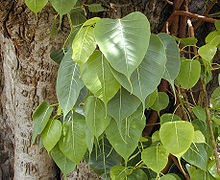
Ficus religiosa

Ficus religiosa or sacred fig is a species of fig native to the Indian subcontinent and Indochina that belongs to Moraceae, the fig or mulberry family. It is also known as the bodhi tree, pippala tree, peepul tree, peepal tree or ashwattha tree (in India and Nepal). The sacred fig is considered to have a religious significance in three major religions that originated on the Indian subcontinent, Hinduism, Buddhism and Jainism. Hindu and Jain ascetics consider the tree to be sacred and often meditate under them and this is the tree under which Gautama Buddha is believed to have attained enlightenment. Ficus religiosa is a large dry season-deciduous or semi-evergreen tree up to 30 metres (98 ft) tall and with a trunk diameter of up to 3 metres (9.8 ft). The leaves are cordate in shape with a distinctive extended drip tip; they are 10–17 centimetres (3.9–6.7 in) long and 8–12 centimetres (3.1–4.7 in) broad, with a 6–10 centimetres (2.4–3.9 in) petiole. The fruits are small figs 1–1.5 centimetres (0.39–0.59 in) in diameter, green ripening to purple. F. religiosa is a tree having a very long lifespan, with an average life ranging between 900–1,500 years. At some of its native habitats, it has been reportedly found living for over 3,000 years. Some trees have been reported to be more than 2,000 years old, like the Jaya Sri Maha Bodhi, a peepal tree in the ancient city of Anuradhapura in Sri Lanka which is estimated to be more than 2,250 years old and is regarded as the 'Oldest historical tree in the world with religious importance'. Banyans have different male and female trees. Ficus religiosa is native to tropical Asia, but it has now been introduced, spread and cultivated around much of the world, and in some cases it has become naturalized where its specialist pollinator wasp (Blastophaga quadriceps) has also been introduced. Ficus religiosa is a species native to the Indian subcontinent and South-East Asian countries such as Bangladesh, Bhutan, China (Yunnan province), India (all states except Andaman and Nicobar Islands), Laos , Nepal, Pakistan, Thailand and Vietnam. It was initially introduced to Sri Lanka in 288 BCE and later to other neighbouring Asian countries like Philippines and Singapore. In Philippines, it was introduced at an early date and now has become widespread throughout the country. Sacred Fig was unintentionally introduced to Israel because of horticulture practices and its associated pollinator wasp was also present in the country by the 1960s, which led to its widespread distribution. In Africa, F. religiosa is a native species of Chad. It is distributed in Egypt and Madagascar where it is cultivated, and Libya where it was introduced and now cultivated. In North America, F. religiosa is distributed only in Mexico and 3 states of the United States where it is cultivated. California, Florida and Hawaii are the only states to have a known distribution of the species.
